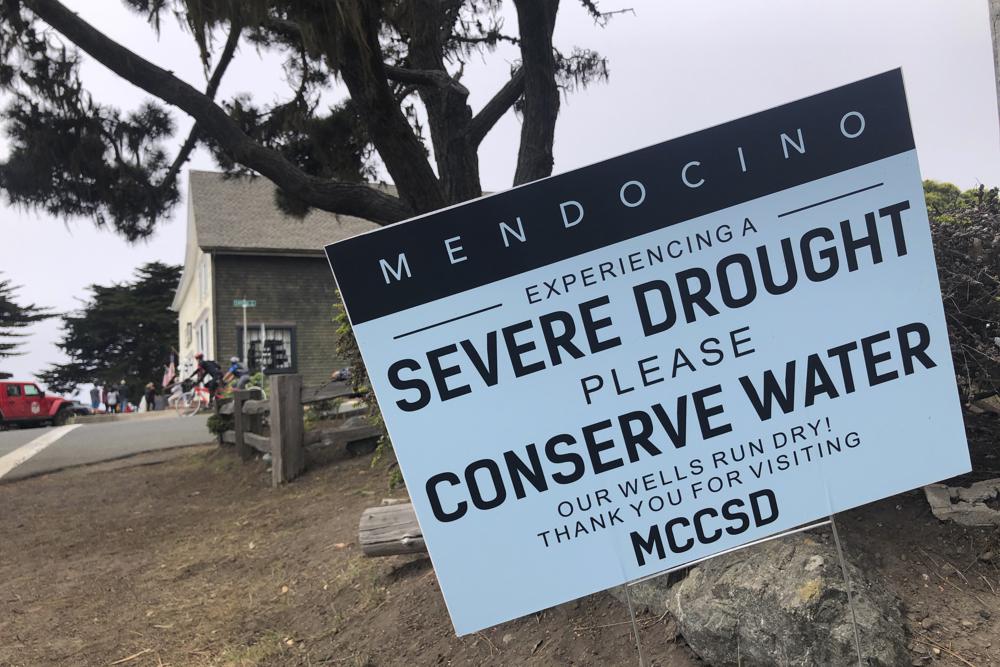Signs alert visitors to the severe drought in Mendocino, Calif., on Wednesday, Aug. 4, 2021. Tourists flock to the picturesque coastal town of Mendocino for its Victorian homes and cliff trails, but visitors this summer will also find public portable toilets and dozens of signs on picket fences announcing the quaint Northern California hamlet: “Severe Drought Please conserve water.” (AP Photo/Haven Daley)
MENDOCINO, Calif. (AP) — Tourists flock by the thousands to the coastal town of Mendocino for its Victorian homes and cliff trails, but visitors this summer are also finding public portable toilets and signs on picket fences pleading: “Severe Drought. Please conserve water.”
Hotels have closed their lobby bathrooms and residents have stopped watering their gardens in the foggy outpost about 150 miles (240 kilometers) north of San Francisco after two years of little rain sapped many of the wells Mendocino depends on for potable water.
Mendocino’s water woes were compounded in recent weeks when the city of Fort Bragg a few miles to the north — its main backup water supplier — informed officials that it, too, had a significant drop in its drinking water reserves after the Noyo River recorded its lowest flows in decades.
“This is a real emergency,” said Ryan Rhoades, superintendent of the Mendocino City Community Services District, which helps manage the water in the town’s aquifer.
Eric Hillesland and his wife normally wouldn’t need to buy water until late July or August to supply the Alegria Inn, their 10-room oceanfront bed and breakfast. But the property’s well started pumping little water early in the year, and by February they were ordering 3,500 gallons (13,250 liters) a week.
Then the couple stopped watering the gardens and switched from glass to paper plates to serve welcome cookies. They plan to start using microfiber bed linens, which take less water to wash.
“We’re also asking our guests to be cognizant of the severity of our water shortage and to not take the extensive showers they might be used to at home,” Hillesland said.
Mendocino relies on groundwater accessed through a network of about 400 privately owned wells, many of them dug by hand when the former mill town was established in the 1850s. Residents and business owners keep their water in storage tanks, including some perched atop historic redwood water towers.
The town has about 1,000 residents, but its economy depends on about 2,000 people who visit each day during the height of the tourist season, from May to October, Rhoades said.
Businesses have traditionally had to haul in water in the fall. But after a second dry winter, many have had to order more, much earlier than before.
Because of the pandemic and stay-at-home orders, there were few visitors last year when town residents began noticing their wells were producing less. Now the weekend getaway destination for people in the Sacramento and San Francisco Bay areas is teeming with guests.
That has forced residents and business owners to find drinking water sources that are farther away, which has doubled the price of water. Some restaurants are cutting back their operating hours to reduce costs.
In February, Hillesland was paying $300 for a 3,500-gallon (13,250-liter) delivery. Now it costs $600.
If it gets worse and they have to start closing rooms, “then we are in a situation like at the beginning of the pandemic — no income but still plenty of mortgage and insurance,” he said.
Many longer-term solutions are being considered, including bringing water by barge, plane and train and adding community storage tanks that can hold up to 500,000 gallons (1.9 million liters), asking the U.S. National Guard or the Army Corps of Engineers to set up a mobile desalination treatment unit, and even capturing fog. But all of them are expensive, and the town would need the support of the state and federal governments, Rhoades said.
A company that developed new technology to capture moisture in fog proposed setting up a testing site in Mendocino at no cost and selling the water to the community. But Rhoades said the infrastructure would affect the town’s scenic views, and getting a permit would be a challenge. A desalination plant would face similar permitting and environmental hurdles.
“Transporting water that is treated, and is known from an inland source, might be a faster solution, even though it’s expensive,” he said.
Robert Pinoli, president of Mendocino Railway, which operates the historic Skunk Train, said he is ready to help. Since 1885, the train has been running from Willits through redwood forests and river canyons to Fort Bragg.
Pinoli said he could find tank cars quickly, attach them to the locomotive and deliver up to 200,000 gallons (757,000 liters) each trip. He identified a source for tank cars in 2015 when Fort Bragg went through a water shortage and considered buying inland water to transport it to the coast. Officials scratched those plans after it rained.
He said if Willits decides it wants to sell its water and Fort Bragg wants to buy it, “we become a logical vehicle for transporting water on a pretty large scale.”
Willits officials recently decided against selling their water to the parched town.
For now, Mendocino residents are relying on people like Brian Clark, who has been selling water from his well outside town and trucking it in. Clark said he can’t keep up with the demand.
“I’m really hiding from the phone, because I’m getting way more calls than I have water, and I’m hearing from people I’ve never met, never heard of, and I can’t help them,” he said.
Clark, a longtime resident, said Mendocino hasn’t had such water storage issues since the 1970s when California faced the most severe drought on record.
County officials’ short-term solutions include waiving permit requirements for storage tanks that can hold up to 5,000 gallons (18,900 liters) and identifying wells with excess water near Mendocino. Officials are also asking the state to help finance the bigger private tanks, Rhoades said.
“I want residents to be able to store more water now, while their wells are still somewhat productive, to make it through the next four months. And if they have to purchase water, you get the most bang for your buck,” he said.
Rodriguez reported from San Francisco.
Copyright 2020 Associated Press. All rights reserved.







































